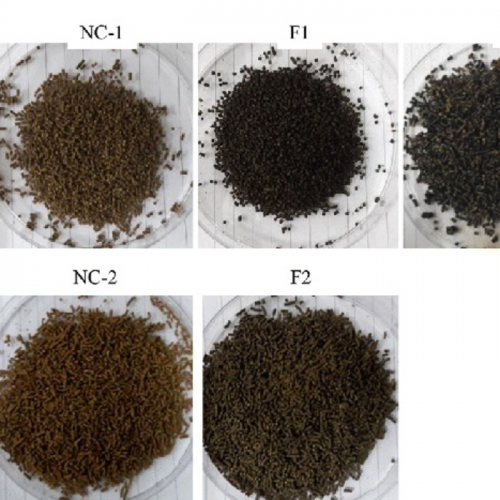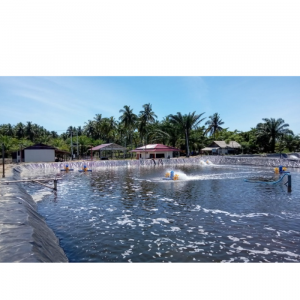
Potential Feed Containing Melanin Protects Vannamei From WSSV Virus
| Tue, 24 Sep 2019 - 15:22
A recent study by Nguyen Dinh Thang et al. 2019, for the first time, found that food supplemented with melanin helps protect whiteleg shrimp from the white spot syndrome virus (WSSV). The report is published in International Aquatic Research.
Whiteleg shrimp ( Litopenaeus vannamei ) is a major species in South Africa and Asia, especially Brazil, Ecuador, Mexico, China, Thailand, Indonesia and Vietnam. However, viral diseases are a serious problem for shrimp industry in these countries. White spot syndrome virus (WSSV) has been considered as one of the most dangerous pathogens that infect shrimp, causing mortality as high as 100% within 7-10 virus infections.
Shrimp immunity is highly dependent on the innate immune system including cellular barrier and humoural these barriers play an important role in protecting shrimp from pathogen attack. In addition, melanization is also an important immune mechanism in shrimp.
Melanin is a naturally occurring polymer with very low toxicity (Garcia Borron et al. 2014). Melanin has many important roles in the human body including absorption of UV radiation, antioxidants and heavy metal absorption. Melanization and melanin secretion help shrimp protect themselves by packaging pathogens and excreting them into the environment. However, no studies have examined the role of melanin as a supplement in protecting shrimp from pathogen attacks. Therefore, in this study, it was the first time to create feed containing melanin and apply them to vannamei ( Litopenaeus vannamei ) farmed to investigate its ability to protect shrimp against WSSV.
Feed containing melanin protects vannamei from WSSV virus
Prepare the food
Natural Melanin is extracted from Squid (Loligo formosana). Commercial granular feed with a diameter of 2 mm is used as the main feed to produce feed containing melanin with different formulations.
Formula 1 (F1): Melanin is coated on the surface of commercial feed particles using cod oil as a binding agent. At first, melanin powder (size <150m) was distributed into cod oil and evenly distributed on commercial feed particles at different ratios (w / w) 1/500, 1/200 and 1 / 50.
Formula 2 (F2): Melanin is mixed with commercial flour and starch solution (3%) used as a binder. First, commercial feed particles are ground into a powder. After that, commercial food flour and melanin powder are mixed at different ratios of 1/500, 1/200 and 1/50 (w / w) and evenly distributed in 3% starch solution. Next, the mixture is extruded to form particles with a diameter of 2 mm.
Formula 3 (F3): Commercial feed particles are dipped directly into the ink liquid at 1/1 (w / v).
Although F1, F2 and F3 feeds were originally created with different levels of melanin / feed , including 1/500, 1/200 and 1/50, the preliminary results of the researchers show. that the 1/200 ratio is the best fit and therefore researchers used the feed at this ratio for subsequent experiments.

A) The dose of WSSV causes 75% of shrimp to die. Mortality was challenged with different doses of WSSV; B) Morphology of negative control (NC) and WSSV-infected shrimp (PC) on day 1 (D1), day 4 (D4), day 7 (D7), day 10 (D10) and day 14 (D14) ; C) Expression of the VP28 gene in PC and NC shrimp after viral infection. The blue and red circles indicate necrotic heads and red tails occurring on WSSV-infected shrimp.
Shrimp were raised and fed with F1, F2 or F3 feed, then challenged with WSSV for 3 days. Dead shrimp are collected and counted.
The results demonstrate that feed preparation formula containing melanin affects the protective ability of melanin supplementation in cultured shrimp . Compound feed F2 has a significantly higher protection rate than feed coated with melanin (F1 and F3). Mixing F2 form can obtain melanin inside feed particles, while formulas coated with F1 and F3 cannot keep melanin in water; Therefore, the amount of melanin consumed when raising F2 shrimp is much higher than that of F1 or F3 cultured shrimp. This result can lead to differences in the protection capacity of feed types. The results of this study showed that the protection rate depends on the amount of melanin that shrimp have consumed; therefore, providing F2 and F3 feed mixtures for shrimp does not appear to have a synergistic effect on the rate of protection.

The amount of melanin consumed by shrimp depends on the type of feed. WSSV-infected shrimp were fed with NC1, F1 and F2 feed, respectively. The red circles indicate different amounts of melanin in the shrimp gut. D) Melanin is released from food into the environment.
The results of this study indicated that protection rates for shrimp fed F2 feed were about 60, 65%. This result is very impressive, but reasonable; Melanin supplementation can only partially help shrimp catch and pack the invasive virus through the digestive system, but it cannot help eliminate the virus that causes shrimp disease by other means of penetration. Therefore, the simultaneous use of other substances that can stimulate the activity of the immune system may be necessary. Moreover, this study used natural melanin extracted from ink bags, which is considered a waste from seafood processing plants. Therefore, using this waste source to produce melanin will bring great benefits because of its low cost.

The results showed that F2 had a 64% protection rate on Saturday and 62% on day 10 after the virus challenge. The protective ability of feed depends on the amount of melanin consumed by shrimp. Moreover, Gen VP28, VP28 (28 kDa) is an important structural protein of WSSV that can be used as a marker to determine the presence of WSSV in water or / and shrimp samples, which have provided presence of WSSV, was significantly reduced in F2 shrimp.
Source : tepbac.com






















